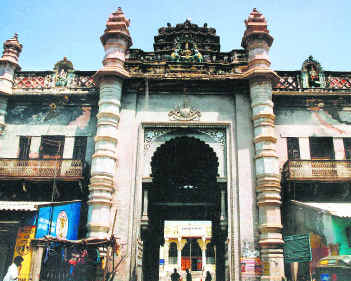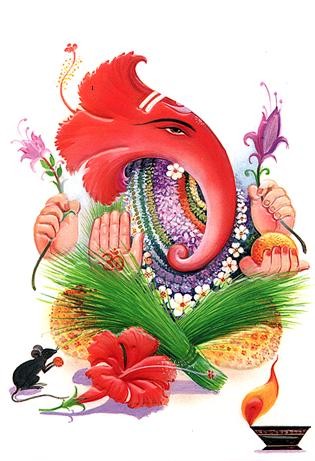Telugu Art of the Sethupathys
KAUSALYA SANTHANAM
| The palace of the former rulers of Ramanathapuram still displays vestiges of regal splendour. |
LIKE dusty sentinels, petty shops crowd the archway to the palace of the former rulers of Ramanathapuram, the Sethupathys. Few, even within this sun-lashed town know that this faded arch leads to buildings that contain some of the most exquisite murals in this part of the country. No other palace in Tamil Nadu has such extensive secular paintings, according to experts. As soon as you enter the freshly colour-washed Mahamandapam, you are surrounded by murals that glint like gem- encrusted jewels on the walls. Some are dull and faded while others flash forth their brilliance even 300 years after they were executed, mostly in the Telugu style of the Nayaks who held sway over the neighbouring large kingdom of Madurai.
In 1978, Ramanatha Sethupathy voluntarily handed over the Ramalinga Vilasam to the Tamil Nadu State Archaeology Department, which conserved and restored portions of it recently.
Range of themes
The paintings cover a staggering range of themes — the epics, Puranas, wars, royal assemblies and romance — and also reflect the Mughal influence. The rotund figures are attired in variously patterned garments and heavy jewellery, both in the traditional and Mughal style while the inscriptions in Telugu and Tamil give details about the panels. The rough block of stone one sees here is the coronation seat of the rulers of Ramanathapuram, similar to the Stone of Scone, the coronation seat of the kings of Scotland. The Sethupathys were protectors of the sacred island of Rameswaram.
A short flight of stairs takes one to the Durbar portion. The ceiling of this hall is covered with a breathtaking array of scenes and floral and geometric motifs. There is such variety and richness here that you wander through the room with constantly upraised head. There are scenes of playful amour and dalliance and of dance recitals and royal sports. Especially interesting is the panel that show Europeans offering gifts and saluting the king. The murals were executed during the reign of Muthu Vijayaragunatha Sethupathy (1710-1725), who figures often in the panels and is seen in one being adorned with gems by the Nayak of Madurai.
Narrow stairs lead to the bedchamber of the Sethupathys. All the frescoes have been restored in this room though some seem over bright.Here there is an unabashed sexuality in the depiction of some of the figures and an inventiveness in the manner in which some of them are fashioned. Most ingenious are those in the Deccani mode, of horses and elephants comprised of women in various poses.
It was in this chamber that the English Collector Jackson is said to have met the great chieftain Veerapandiya Kattabomman of Panchalankurichi, one of the earliest freedom fighters who rebelled against the British yoke.
The palace complex has a cluster of buildings in various stages of maintenance. The chief among them is the temple of Sri Rajarajeswari, the tutelary deity of the rulers. The sovereign of Madurai, Tirumalai Nayak gifted the golden idol to the Sethupathys. The temple has just closed but the white bearded, third generation priest allows you to have a glimpse of the deity through a chink in the door.
Among the rulers of Ramnad, Bhaskara Sethupathy was famed for his munificence and religious activities. It was he who encouraged Swami Vivekananda to visit Chicago to participate in the Parliament of World Religions. As we leave the main building a convoy of cars rushes in . Uma Bharti is on her "Bharat bachao" yatra and has just stepped into the Vivekananda Bhaskara hall within the palace premises to lay flowers at the portraits of Sri Ramakrishna Paramahamsa and Sarada Devi.
Portraits and arms of the rulers are displayed at the Ramalinga Vilasam, which is open to visitors at a nominal fee.
As with most minor or major princely houses, disputes about property affect the Ramnad family. Claimants to the Government pension include the descendants of the "rebel" king Muthuramalinga Sethupathy who courageously raised his voice and might against the British, and was deposed in 1795.
The heiress is now Rajeswari Nachiyar, the only offspring of the late Ramanatha Sethupathy and Indira devi. The simple and unassuming rani, who is hereditary trustee of numerous temples, lives in Chennai with her engineer husband and two children. Her cousin Kumaran and his wife have recreated a sort of aristocratic splendour in their high vaulted portion of the palace and run a school in the former zenana. As one goes though the many pillared zenana and sees "Play time" and "UKG" written on the walls, one feels yet again how past and present co-exist, often incongruously, as former Zamindars and royals make an attempt to find their place in contemporary times.
History of the Sethupathys
THE Sethupathys claim an ancient lineage. But the line can be clearly traced from the 17th century Hailing from the Maravar clan, they were hereditary chieftains who enjoyed a fair degree of independence from the suzerainty of the Pandya and Nayak kings.
Among the distinguished rulers were Thirumala Sethupathy who united and expanded the territories, Kilavan Sethupathy who constructed Ramalingavilasam and Muthu Vijayaraghunatha Sethupathy. Ramanathapuram was reduced to a zamindari by the East India Company in 1803.
Shanmugha Rajeswara Sethupathy was a minister in Rajagopalachari's cabinet. The Sethupathys patronised the arts and some of the rulers were writers of merit.
Source: District Gazette
Courtesy: The Hindu





2 Comments:
coach outlet
michael kors bags
ugg boots
nike huarache
ray ban sunglasses
michael kors outlet
kate spade outlet
polo ralph lauren
polo ralph lauren
cheap jordan shoes
49ers jersey
mbt shoes outlet
kate spade sale
coach handbags
cheap ray ban sunglasses
coach handbags
coach outlet online
tennessee titans jersey
fitflops shoes
falcons jersey
Post a Comment
<< Home